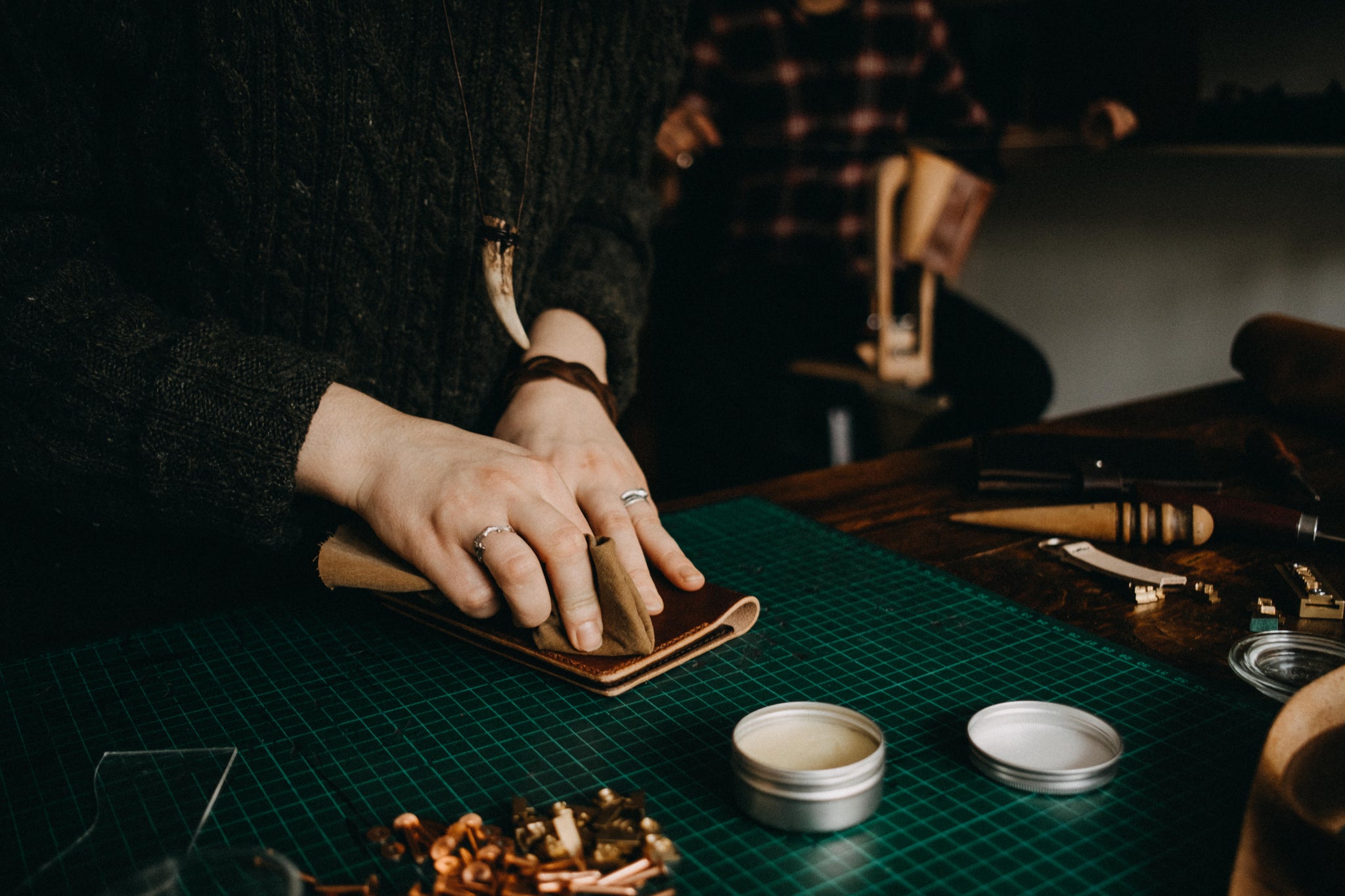Leather care

Most of the leather we use for our products is vegetable tanned and it ages incredibly, especially if it receives a bit of care once in a while.
What is vegetable tanned leather?
When it comes to caring for our products, or for leather goods in general, here are our recommendations:
First, the obvious: DON'T go scuba-diving or swimming while wearing leather items (bracelet, necklace, belt, watch strap etc.).
If you don't do that, you're already doing a great job at protecting your leather goods!
Quick guide:
Keep leather goods away from from prolonged sunlight exposure as this can cause fading.
Don't machine wash leather.
Don't get leather wet wherever possible.
If leather gets wet, blot the water away as soon as possible.
Don't dry wet leather next to a radiator or with a hairdryer. Don't tumble dry. Don't iron. Don't immerse leather in water to clean.
Store leather away from artificial sources of heat, as they can cause leather to dry and crack.
Keep leather supple with leather balms and conditioners.
In-Depth to guide:
How to DRY the leather: Do not attempt to dry your leather using strong heat sources such as a hairdryer or fan heater. Keep the leather away from direct sunlight or strong heat sources and let it dry on its own. Store in a clean, dry & ventilated area! If your item is stored in a closed & damp place (bottom of your wardrobe, under the bed, broom closet and other spaces) the leather can grow mouldy.
How to CLEAN the leather:
Mix a solution of warm water and unscented dish soap or castile soap (we recommend unscented Dr. Bronner's castile soap) at a ratio of 10 to 1 (10 parts water, 1 part soap).
You will need a soft cloth, preferably one that does not leave lint on the leather (dish towels are a great example).
Step 1: Dip the cloth into the mixture, wring it out and proceed to gently wipe the exterior surfaces of the leather.
Step 2: Use a second, damp cloth (dipped in water only) to wipe off the soap.
Step 3: Dry with a soft towel.
Allow the leather to dry completely before conditioning it.
How to CONDITION the leather:
If your product starts to look dry, take the time to give it a little bit of care to ensure its durability, using a conditioning treatment. You can find in our shop our own leather balm, mixed & poured in small batches in our studio using only natural & organic oils and waxes. It contains organic beeswax that provides water resistance and a variety of oils that each provides the leather with valuable nourishing elements. If you already have a product, make sure it's a good quality leather balm & that it contains the least amount of chemicals and coloring agents.
Once a year is enough for most leather goods that are stored properly and used just occasionally. For items used frequently, especially outdoors in direct sun or rain, more frequent conditioning is recommended. For example, shoes are the most exposed to the elements, so we recommend conditioning monthly to keep the leather supple & avoid unaesthetic cracks.
One thing to keep in mind before conditioning is that the product will darken a bit after each balm application. You should not worry about this 'side effect' as it is absolutely normal! In fact, frequent conditioning speeds up the patina development (darkening of the leather that comes as a result of the aging process).
If you are trying to give your new leather shoes a more worn/vintage look to match your leather belt, for example, conditioning the leather a few times in a row will help you acquire the patina much faster than normal wear. Just remember to allow 24 hours between each coating with balm!


STEP BY STEP:
Make sure your leather product is clean and dry.
You will need 2 clean pieces of cloth & a conditioning product (we recommend our hand poured leather balm ). You can also use oils, like neatsfoot oil or olive oil if your item is not exposed to water.
Step 1: With one rag, rub a thin coat of balm on the product using circular movements. Do not over-do this step as a thick layer might obstruct leather breathability and lead to mildew growth. If your product is worryingly dry, apply a thin coat and allow 24 hours before applying a second thin coat of balm.
Step 2: Buff dry the product using the second, dry rag.
EXTRA TIPS:
Your leather goods should be stored in a clean and dry place. If you live in an area with heavy winters, we recommend treating the shoes and bags that are exposed to rain and snowfall more frequently. Clean the shoes often to prevent the damage caused by the salts on the pavement (in areas with heavy snowfall, the streets are treated with salt to prevent them from becoming slippery).
STORAGE for winter shoes: After their last use, clean the salt and /or mud off your winter shoes after their last use, before storing them away over the spring & summer. Allow them to dry completely, then proceed to condition the leather to prevent them from drying out over the summer.
If you have any further questions about leather care, please contact us at info@bengjyminu.com
